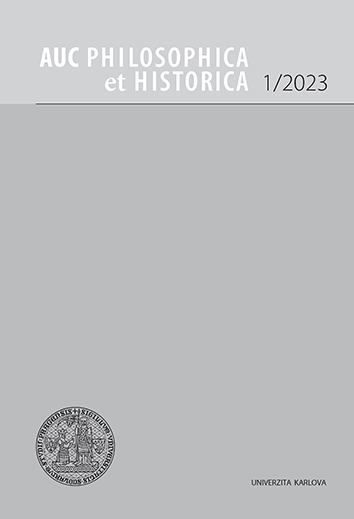AUC Philosophica et Historica je víceoborový akademický časopis zaměřený na humanitní a společenskovědné obory (filozofie, psychologie, pedagogika, sociologie, obecné, české a hospodářské dějiny, pomocné vědy historické a archivnictví, etnologie).
Časopis je indexován v databázích CEEOL, DOAJ a EBSCO.
AUC PHILOSOPHICA ET HISTORICA, Vol 2019 No 2 (2019), 229–235
Umění jako bdělý sen. Kritika revidované definice umění Arthura C. Danta
[Art as a Wakeful Dream. Criticism of Arthur C. Danto‘s Revisited Definition of Art]
Šárka Lojdová
DOI: https://doi.org/10.14712/24647055.2020.16
zveřejněno: 14. 09. 2020
Abstract
Arthur C. Danto is considered one of the most influential analytical philosophers of art of 20th century. He introduced the notion “artworld” into the art-historical and philosophical vocabulary and he was one of the first analytical philosophers who payed attention to art of Modernism. Danto was interested in a question of art definition and offered a solution based on the principle of indiscernibles. However this solution seemed not to be a plausible one in the course of time and Danto himself decided to reconsider his definition. In the first part of this article, I concern with a characterization of art as “embodied meanings”, i.e. with Danto’s first version of definition held until his last book What Art Is was published in 2013. In the second part, I focus on criticism of Danto’s cognitivism in the article “Whatever happened to ‘embodiment’? The eclipse of materiality in Danto’s ontology of art” by Diarmuid Costello. Costello argues that Danto’s notion of interpretation is not sufficient for our treating artworks as artworks and that it was Danto’s insufficient attention to interaction of a meaning of an artwork and its embodiment which is responsible for this mistake. In the last section of this paper, I shall compare Costello’s strictures on Danto’s art definition with Danto’s revisited version introduced in What Art Is. My aim is to answer the question whether this version of definition is more resistant to Costello’s criticism or not.
klíčová slova: art definition; Arthur Danto; embodied meanings; Diarmuid Costello; wakeful dreams
reference (11)
1. Noël Carroll. Essence, Expression and History, in: Mark Rollins (ed.) Danto and his Critics, 2. vyd., New Jersey 2012. CrossRef
2. Diarmuid Costello, Whatever happened to "embodiment"? The eclipse of materiality in Danto's ontology of art, Angelaki: Journal of the Theoretical Humanities XII, 2007, č. 2. CrossRef
3. Arthur Danto, The Transfiguration of the Commonplace, Cambridge 1981.
4. Arthur Danto, The Appreciation and Interpretation of Works of Art, in: idem The Philosophical Disenfranchisement of Art, New York - Chichester 1986.
5. Arthur Danto, The Philosophical Disenfranchisement of Art, in: idem The Philosophical Disenfranchisement of Art, New York - Chichester 1986. CrossRef
6. Arthur Danto, After the End of Art, Chichester 1997.
7. Arthur Danto, The Abuse of Beauty, Chicago - La Salle 2003.
8. Arthur Danto, What Art Is, New Haven - London 2013.
9. René Descartes, Meditace o první filosofii, Praha 2015.
10. Tomáš Kulka - Denis Ciporanov, Co je umění?, Červený Kostelec, 2010.
11. Platón, Ústava, Praha 2005.

Umění jako bdělý sen. Kritika revidované definice umění Arthura C. Danta is licensed under a Creative Commons Attribution 4.0 International License.
